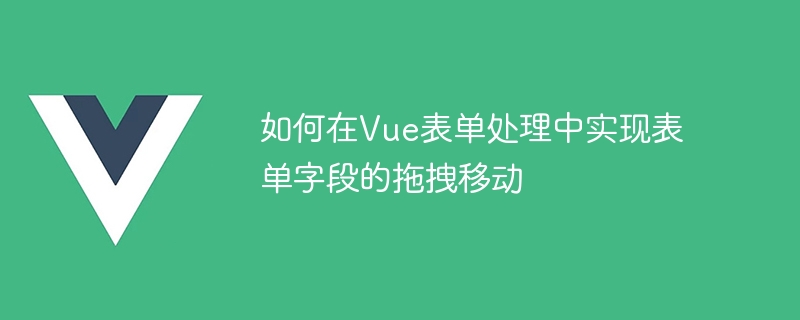

How to implement drag-and-drop movement of form fields in Vue form processing
In Vue development, the form is a very common component, and sometimes we need to modify the form Fields can be dragged and moved. This article will introduce how to implement drag-and-drop movement of form fields in Vue form processing, and provide corresponding code examples.
1. Use the Vue.Draggable plug-in
Vue.Draggable is a drag-and-drop plug-in based on Vue, which can help us achieve the drag-and-drop effect of elements. The following are the basic steps to use the Vue.Draggable plug-in to implement drag and drop movement of form fields:
Use npm or yarn to install Vue in the project. Draggable plug-in:
npm install vuedraggable --save
Introduce Vue.Draggable into the Vue component and register it as a global component:
import draggable from 'vuedraggable';
Vue.component('draggable', draggable);Define the form field list in data. The data of each field includes the field name and field type:
data() {
return {
formFields: [
{ name: '用户名', type: 'text' },
{ name: '密码', type: 'password' },
{ name: '邮箱', type: 'email' },
// ...
]
}
}Use the Vue.Draggable component in the template to display the form field list and achieve the drag and drop effect:
<draggable v-model="formFields" group="formFieldsGroup">
<div v-for="(field, index) in formFields" :key="index">
<div>{{ field.name }}</div>
<div>{{ field.type }}</div>
</div>
</draggable>In the above code, use the v-for instruction loop Display a list of form fields and add drag and drop effects to each field.
When the user drags and moves the form fields, Vue.Draggable will automatically update the sorting of the form field list. We can get the latest form field order by listening to the dragend event:
<draggable v-model="formFields" group="formFieldsGroup" @end="onDragEnd">
<!-- ... -->
</draggable>
methods: {
onDragEnd() {
console.log(this.formFields);
}
}In the onDragEnd method, we can get the latest form field order.
2. Save the order after dragging and moving
Through the above steps, we have achieved the drag and drop effect of the form fields, but when the page is refreshed, the sorting of the form fields will be restored. is the initial state. To solve this problem, we need to save the order of the form fields to the backend or local storage.
Here, we use localStorage to save the order of form fields. The following are the specific implementation steps:
Add a localStorage tool function to the project to read and save the order of form fields. . You can create a utils.js file and add the following code:
export function getFormFields() {
return JSON.parse(localStorage.getItem('formFields')) || [];
}
export function saveFormFields(formFields) {
localStorage.setItem('formFields', JSON.stringify(formFields));
}In the created life cycle of the Vue component, read from localStorage Get the form field order and update the form field list:
import { getFormFields, saveFormFields } from 'utils';
export default {
// ...
created() {
this.formFields = getFormFields();
},
// ...
}In order to monitor the change of the form field order in real time, you need to drag and drop Update the data in localStorage after completion:
<draggable v-model="formFields" group="formFieldsGroup" @end="onDragEnd">
<!-- ... -->
</draggable>
methods: {
onDragEnd() {
saveFormFields(this.formFields);
}
}Through the above steps, we successfully implemented the function of dragging and moving form fields and saving the order.
Summary:
This article introduces how to use the Vue.Draggable plug-in in Vue form processing to implement drag-and-drop movement of form fields, and to save the order of form fields through localStorage. In this way, we can easily customize the order of form fields, improving user experience and operational flexibility.
The above is all about how to implement drag-and-drop movement of form fields in Vue form processing. I hope it will be helpful to you.
The above is the detailed content of How to implement drag-and-drop movement of form fields in Vue form processing. For more information, please follow other related articles on the PHP Chinese website!